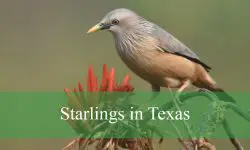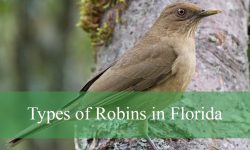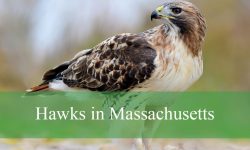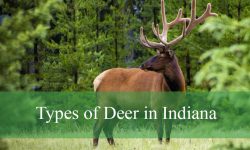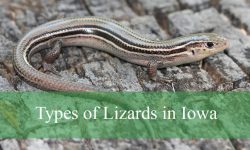Feral pigs are one of the most widespread and adaptable invasive species in North Carolina. They cause significant damage to crops, forests, and native wildlife while posing health risks to livestock and humans.
These pigs include European or Russian wild boars, feral domestic pigs, and hybrid wild pigs. Although they belong to the same species, Sus scrofa, each type has distinct traits, behaviors, and origins that influence how they impact the environment.
Understanding the differences between these types helps landowners, hunters, and wildlife managers identify them and implement effective control measures. From physical characteristics to social behavior and habitat preferences, knowing what sets each type apart is essential for managing their populations.
Common Feral Pigs Found in North Carolina
Hybrid Wild Pigs
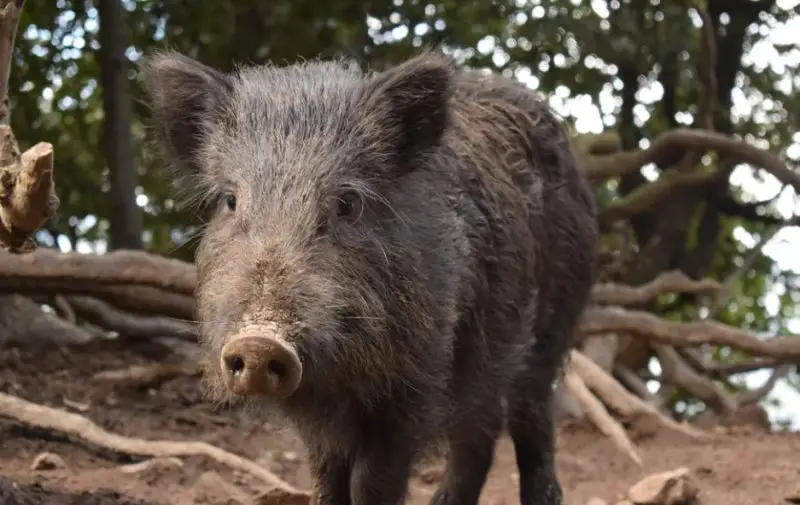
Hybrid wild pigs are the most widespread and adaptable type of feral pig in North Carolina. They result from interbreeding between escaped or released domestic pigs and European or Russian wild boars. This genetic mix produces animals with a combination of traits: they often retain the hardiness, large tusks, and muscular build of wild boars while also displaying some of the size variation and social behavior of domestic pigs. Compared to pure domestic pigs, hybrids are more aggressive, intelligent, and cautious around humans, making them harder to manage in the wild.
The physical appearance of hybrid wild pigs is highly variable due to their mixed genetics. Coat colors can range from solid black, brown, and reddish tones to mixed or spotted patterns. Piglets are typically born with distinct stripes or patches that serve as camouflage in forested habitats, but these markings fade as the animals mature.
The size of hybrids can vary widely: some males may weigh over 200 pounds, while others are smaller, depending on the proportion of domestic pig ancestry. Their heads are typically broad with a pronounced snout, and their tusks grow continuously, curving outward as they age.
Behaviorally, hybrid wild pigs are highly adaptable and opportunistic feeders. They are omnivorous, rooting through soil for roots, tubers, insects, small animals, and even carrion. This foraging behavior can cause extensive soil disruption, erosion, and damage to crops and native vegetation.
Hybrid wild pigs live in social groups called sounders, which usually consist of sows and their offspring. Mature boars often live alone, joining the group only during mating periods. Their ability to move quickly, navigate diverse terrains, and reproduce rapidly makes them particularly challenging to control.
These pigs thrive in a wide range of habitats, including hardwood and pine forests, swamps, marshes, and farmlands. They are highly intelligent and can detect humans from a distance, often fleeing before being approached. Their adaptability allows them to survive harsh winters, periods of drought, and areas with limited food sources.
Ecologically, hybrid wild pigs disrupt native plant and animal communities, compete with wildlife for resources, and pose risks of disease transmission to livestock and humans. Managing their populations is therefore a major concern for wildlife authorities and landowners throughout North Carolina.
Feral Domestic Pigs

Feral domestic pigs originate from pigs that were abandoned or escaped from farms. Over multiple generations, these pigs adapt to life in the wild, often developing traits similar to wild boars. While they retain some domestic characteristics, such as a shorter snout or smaller tusks, they become more aggressive, intelligent, and resilient in natural environments, making them difficult to manage once established.
The coloration of feral domestic pigs is highly variable. Some individuals are white or pink, while others display darker shades or even spots. Unlike European wild boars, they often lack coarse, bristly hair, giving them a softer appearance. Generally smaller than hybrid pigs, feral domestic pigs can still reproduce rapidly, allowing populations to grow quickly in rural and wooded areas.
Behaviorally, feral domestic pigs are omnivorous and opportunistic feeders. They root through soil in search of roots, tubers, insects, and small animals, which can significantly disrupt local ecosystems and damage farmland. They live in social groups known as sounders, typically made up of related sows and their piglets. Adult males are more solitary but join the group during mating season.
Feral domestic pigs are highly adaptable to different habitats, including forests, wetlands, and agricultural lands. They can survive in a variety of conditions, from harsh winters to periods of drought, making them a persistent presence wherever they establish. Their foraging and social behavior can cause both ecological and agricultural damage, including soil erosion, destruction of native plants, and competition with native wildlife.
Managing feral domestic pig populations is critical to reducing their impact on the environment and limiting the spread of diseases to livestock and humans. Effective strategies often include hunting, trapping, and strict regulations to prevent domestic pigs from escaping into the wild.
European or Russian Wild Boars
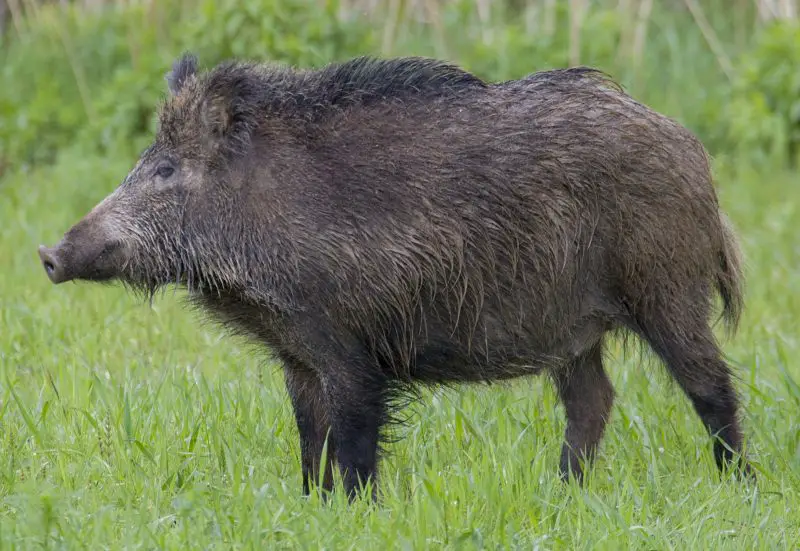
European or Russian wild boars were originally introduced to the United States for hunting purposes. Over time, some escaped or were intentionally released into the wild, where they became part of the feral pig population in states like North Carolina. These wild boars are generally larger and more heavily muscled than domestic pigs or hybrids, with coarse, dark hair that gives them a distinctly wild and formidable appearance.
Their physical features are adapted for survival in the wild. They have long, sharp tusks and elongated snouts, which allow them to dig efficiently for roots, tubers, and other food sources. Adult males tend to be solitary, while females and young form social groups called sounders. This structure allows them to forage effectively while maintaining protection for the young. European and Russian wild boars are highly wary of humans, making them more difficult to hunt or trap compared to feral domestic pigs.
Behaviorally, these wild boars are extremely adaptable. They can survive harsh winters, floods, droughts, and periods of scarce food. Their omnivorous diet includes roots, small animals, insects, and carrion, which enables them to thrive in a variety of habitats, from dense forests to swamps and wetlands.
Reproductively, wild boars are prolific breeders. When they interbreed with domestic pigs, they produce hybrids that inherit the strength and aggressiveness of wild boars along with the adaptability and fast growth of domestic pigs. This hybridization significantly contributes to the expansion and resilience of the feral pig population in North Carolina.
European and Russian wild boars have a substantial ecological impact. They disrupt native plant and animal communities, compete with native wildlife for resources, and pose risks of disease transmission to livestock and humans. Effective management of these populations is essential to limit environmental and agricultural damage throughout the region.
Comparison of Feral Pigs in North Carolina
Attribute |
European/Russian Wild Boars |
Feral Domestic Pigs |
Hybrid Wild Pigs |
|---|---|---|---|
Origin |
Introduced for hunting, some escaped into the wild |
Domestic pigs abandoned or escaped from farms |
Result from interbreeding between domestic pigs and European/Russian wild boars |
Size & Build |
Large, heavily muscled; long tusks |
Small to medium; retain some domestic features like shorter snout |
Medium to large; muscular, often with large tusks |
Coat & Appearance |
Dark, coarse hair; elongated snout |
Variable: white, pink, darker shades, sometimes spotted; softer hair |
Variable: black, brown, red, mixed; piglets may have stripes |
Behavior |
Wary of humans, omnivorous; dig for roots and tubers |
Omnivorous, opportunistic feeders; can be aggressive |
Aggressive, intelligent, wary of humans, omnivorous |
Social Structure |
Sounders of females + young; males mostly solitary |
Live in sounders of related sows and piglets; adult males solitary |
Live in sounders (sows + piglets); adult males mostly solitary |
Adaptability & Impact |
Extremely adaptable; survive harsh conditions; interbreed with domestic pigs to create hybrids; ecological impact significant |
Adaptable to forests and farmland; disrupt ecosystems; reproduce quickly |
Highly adaptable; damage crops, native vegetation, and ecosystems; reproduce rapidly |
FAQs About Feral Pigs in North Carolina
What species are feral pigs in North Carolina?
Feral pigs in North Carolina are all part of the species Sus scrofa. They include European or Russian wild boars, feral domestic pigs, and hybrid wild pigs, which differ mainly in origin, genetics, and physical traits.
How can I identify hybrid wild pigs?
Hybrid wild pigs are a mix of domestic pigs and wild boars. They often have muscular bodies, large tusks, and variable coat colors, including black, brown, red, or mixed patterns. Piglets may have stripes that fade as they grow. They are highly adaptable and aggressive compared to pure domestic pigs.
Are feral domestic pigs dangerous?
Yes, feral domestic pigs can be dangerous. They are omnivorous and opportunistic feeders, capable of rooting through soil and crops, causing ecological and agricultural damage. They can also carry diseases that may affect livestock and humans.
Where do European or Russian wild boars live in North Carolina?
European or Russian wild boars prefer dense forests, swamps, and wetlands. They are highly wary of humans and often live in sounders composed of females and young, while mature males are mostly solitary.
How do feral pigs impact the environment?
Feral pigs disrupt native plant and animal communities, compete with wildlife for food, and damage crops. Their rooting behavior causes soil erosion and habitat destruction. They can also spread diseases to livestock and humans.
Can feral pigs interbreed?
Yes, feral pigs of different types readily interbreed. European or Russian wild boars can breed with domestic pigs, producing hybrid wild pigs that combine the strength and aggression of wild boars with the adaptability and reproductive speed of domestic pigs.
How are feral pigs managed in North Carolina?
Management includes hunting, trapping, and preventing domestic pigs from escaping into the wild. North Carolina allows regulated hunting of feral pigs, and landowners often implement traps to reduce populations and limit ecological and agricultural damage.

